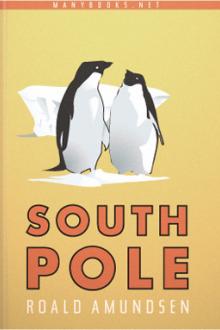The North Pole by Robert E. Peary (room on the broom read aloud .TXT) 📕

- Author: Robert E. Peary
- Performer: -
Book online «The North Pole by Robert E. Peary (room on the broom read aloud .TXT) 📕». Author Robert E. Peary
These houses are about six feet high by eight to ten feet wide by ten to twelve feet long, and one may be constructed in a month. An excavation is made in the earth, which forms the floor of the house; then the walls are built up solidly with stones chinked with moss; long, flat stones are laid across the top of the walls; this roof is covered with earth, and the whole house is banked in with snow. The construction of the arched roof is on the plan which engineers know as the cantilever, and not that of the Roman arch. The long, flat stones which form the roof are weighted and counter-weighted at the outer ends, and in all my arctic experience I have never known the stone roof of an igloo to fall upon the inmates. There are never any complaints made to the Building Department. There is no door in the side, but a hole in the floor at the entrance leads to a tunnel, sometimes ten, sometimes fifteen, or even twenty-five, feet in length, through which the tenants crawl into their home. There is always a small window in the front of the igloo. The window space is not glazed, of course, but is covered with the thin, intestinal membrane of seals, skilfully seamed together. To a traveler across the dark and snowy winter waste, the yellow light from the interior lamp is visible, sometimes, a long distance away.
At the farther end of the igloo is the bed platform, raised about a foot and a half above the earthen floor. Usually this platform is not built, but is the natural level of the earth, the standing space being dug before it. In some houses, however, the bed platform is made of long, flat stones raised upon stone supports. When the Eskimos are ready to move into the stone houses in the fall, they cover the bed platform first with grass, which they bring in by the sledge-load; the grass is then covered with sealskins; above these are spread deerskins, or musk-ox skins,—which form the mattress. Deerskins are used for blankets. Pajamas are not in fashion with the Eskimos. They simply remove all their clothes and crawl in between the deerskins.
The lamp, which stands on a large stone at the front of the bed platform on one side, is kept burning all the time, whether the family is asleep or awake. An imaginative person might liken this lamp to an ever-burning sacred flame upon the stone altar of the Eskimo home. It serves also as a stove for heating and cooking, and makes the igloo so warm that the inhabitants wear little clothing when indoors. They sleep with their heads toward the lamp, so the woman may reach out and tend it.
On the other side of the house food is generally stored. When two families occupy one igloo, there may be a second lamp on the other side; and in that case the food must be stored under the bed. The temperature of these houses varies from eighty or ninety degrees Fahrenheit, on the bed platform and near the roof, to something below freezing point at the floor level. There is a little air-hole in the center of the roof, but in the happy home of an Eskimo family, in winter, the atmosphere could almost be handled with a shovel.
Often, in winter traveling, I have been obliged to sleep in one of these hospitable igloos. On such occasions I have made the best of things, as a man would if compelled to sleep in a tenth-rate railroad hotel or a slum lodging-house, but I have tried to forget the experience as soon as possible. It is not well for an arctic explorer to be too fastidious. A night in one of these igloos, with the family at home, is an offense to every civilized sense, especially that of smell; but there are times when a man, after a long sledge journey in the terrible cold and wind, hungry and footsore, will welcome the dim light shining through the translucent window of an igloo as one welcomes the light of home. It means warmth and comfort, supper, and blessed sleep.
There is no blinking the fact that my Eskimo friends are very dirty. When I have them on the ship with me they make heroic efforts to wash themselves occasionally; but in their own homes they practically never do, and in winter they have no water except from melted snow. On rare occasions, when the dirt gets too thick for comfort, they may remove the outer layer with a little oil. I shall never forget the amazement with which they made acquaintance with the white man's use of the tooth-brush.
With the coming of the summer, the stone and earth houses become damp, dark holes, and the roofs are taken off to dry and ventilate the interior. The family then moves outside and sets up the tupik, or skin tent, which is their home from about the first of June till some time in September. The tupik is made of sealskins, with the hair on the inside. Ten or twelve skins, sewed together in one large piece, make a tent. It is stretched on poles, high in front and sloping toward the back, thus offering the least possible resistance to the wind, the edges held down with stones. The earth floor of these tents is six or eight feet wide and eight or ten feet long, according to the size of the family.
In recent years my Eskimos have adopted an improvement upon the building customs of the west coast natives, and many of them have an entrance extension to their tents made of transparent tanned sealskins, thick enough to keep out the rain but not the light. This adds to the roominess and comfort of their summer dwellings. A usual practice among the better class of Eskimos is to use the old tupik of the previous summer for a rain or weather-guard to the new tent. In heavy winds or heavy summer rains, the old tupik is simply spread over the new one, thus giving a double thickness and protection to the owners.
The bed platform in the tupik is now generally made of lumber, which I have furnished, raised on stones, and in pleasant weather the cooking is done outside. Oil is the only fuel for heat, light, and cooking. The Eskimo women trim the lamps so well that there is no smoke from them, unless there is a draft in the tent or igloo. They cut small pieces of blubber, which they lay on moss and ignite, and the heat from the moss dries out the oil, making a surprisingly hot flame. Until I gave them matches, they had only the primitive means of ignition by flint and steel, which they obtained from a vein of pyrites. When I first went up there, all their lamps and rectangular pots were made of soapstone, two or three veins of which are found in that country. Their ability to utilize the soapstone and pyrites is an illustration of their intelligence and ingenuity.
As a rule little clothing is worn in the tupiks in warm weather, as the normal summer temperature is around fifty degrees Fahrenheit, and in the strong sunlight may go as high as eighty-five or even ninety-five.
The trial marriage is an ineradicable custom among the Eskimos. If a young man and woman are not suited with each other, they try again, and sometimes several times; but when they find mates to whom they are adapted, the arrangement is generally permanent. If two men want to marry the same woman, they settle the question by a trial of strength, and the better man has his way. These struggles are not fights, as the disputants are amiable; they are simply tests of wrestling, or sometimes of pounding each other on the arm to see which man can stand the pounding the longer.
Their fundamental acceptance of the proposition that might is right in such matters sometimes extends to a man saying to the husband of a woman: "I am the better man." In such case the husband has either to prove his superiority in strength, or yield the woman to the other. If a man grows tired of his wife, he simply tells her there is not room for her in his igloo. She may return to her parents, if they are living; she may go to a brother or a sister; or she may send word to some man in the tribe that she is now at liberty and is willing to start life again. In these cases of primitive divorce, the husband keeps one or all of the children if he wants them; if not, the woman takes them with her.
ESKIMO MOTHER AND CHILD
The Eskimos do not have many children, two or three being the usual number. The woman does not take her husband's name in any case. Akatingwah, for instance, will remain Akatingwah, whether she has had one husband or several. Children do not address their parents as father and mother, but call them by their names, though sometimes very small children use a diminutive which corresponds to our "mamma."
Among the Eskimos the woman is as much a part of the man's property as his dog or sledge—except in some rare cases. The cause of the suffragettes has as yet made little headway in this region. I remember one instance in which an Eskimo woman had a difference of opinion with her husband, and proved her right to independence by blackening the old man's eye; but I am afraid that the more conservative members of the tribe attributed this unfeminine behavior to the corrupting influence of contact with civilization.
As there are more men than women among the Eskimos, the girls marry very young, often about the age of twelve. In many cases the marriages are arranged between the parents when the children are quite young; but the boy and girl are not bound, and when they are old enough they are permitted to decide for themselves. In fact, they can make several such decisions without losing caste. On the last expedition, as on those of former years, I found that a number of matrimonial changes had taken place among my Northern friends since I was last among them.
ESKIMO CHILDREN
It would be worse than useless to attempt to engraft our marriage customs upon these naive children of Nature. Should an arctic explorer consider it his duty to tell a young Eskimo that it was not right for him to exchange wives with his friend, it would be well for the explorer to have his supporting argument well prepared beforehand, for the censured one would probably open wide his eyes and inquire, "Why not?"
These people of the ice-land, like all intelligent savages, are remarkably curious. If confronted, say, with a package containing various supplies unknown to them, they will not rest until they have examined every article of the lot, touched it, turned it over, and even tasted it, chattering all the while like a flock of blackbirds.





Comments (0)